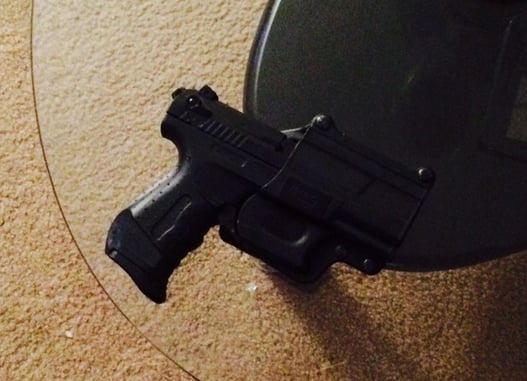De-escalation is a critical skill for armed citizens to prevent violent encounters and ensure responsible gun ownership. This article covers essential de-escalation techniques, their importance, and practical tips for armed self-defense.
Table of Contents
What Is De-escalation?
De-escalation is a set of techniques and strategies used to prevent conflicts from escalating into violence. These methods involve calming down tense situations, reducing the potential for physical confrontation, and resolving disputes peacefully. For armed citizens, mastering de-escalation is crucial. It can prevent the need to use a firearm and help avoid legal and moral repercussions.
The Importance of De-Escalation for Armed Citizens
Legal Implications
The use of a firearm in self-defense carries significant legal responsibilities. Even in cases where lethal force is justified, armed citizens can face extensive legal scrutiny. Demonstrating an attempt to de-escalate a situation can provide a strong defense in court, showing that lethal force was a last resort. Courts and juries often look favorably upon individuals who made a sincere effort to avoid a bad situation before resorting to the use of a firearm.
Moral Responsibility
The decision to carry a firearm comes with a profound moral obligation to use it responsibly. De-escalation reflects a commitment to preserving life and ensuring that violence is only a last resort. As a firearm owner, the ultimate goal should be to protect oneself and others while minimizing harm. This moral duty extends beyond legal requirements, embodying the ethical standards expected of responsible gun owners.
Personal Safety
Engaging in a physical confrontation can lead to injury or death. De-escalation techniques help avoid dangerous situations, protecting both the armed citizen and others involved. By successfully de-escalating a conflict, an armed citizen reduces the risk of harm and increases the likelihood of a peaceful resolution. This not only ensures personal safety but also preserves the safety of the community.
Community Impact
Responsible firearm ownership includes being a positive role model within the community. Practicing de-escalation demonstrates a commitment to safety and conflict resolution, promoting a culture of responsibility. When armed citizens use de-escalation techniques, they contribute to a safer environment and set a standard for others to follow. This can lead to a more harmonious community where conflicts are resolved peacefully.
Tips for Effective De-Escalation
Maintain Composure
Staying calm is crucial in any potentially volatile situation. Displaying anger or aggression can escalate the situation rapidly. Take deep breaths, speak slowly, and keep your tone neutral. A composed demeanor can have a calming effect on others, helping to de-escalate tensions. Remember, the goal is to reduce the intensity of the situation, not to match or escalate it.
Use Non-Threatening Body Language
Your body language can significantly impact the situation. Keep your hands visible, avoid aggressive gestures, and maintain an open posture. Non-verbal cues play a vital role in communication and can either escalate or de-escalate a conflict. By using non-threatening body language, you signal to others that you are not a threat and are open to resolving the situation peacefully.

Active Listening
Show that you are listening by nodding and making eye contact. Let the other person speak without interruption. This can help them feel heard and reduce their aggression. Active listening involves more than just hearing words; it requires understanding and empathy. By truly listening to the other person, you can address their concerns more effectively and find a peaceful resolution.
Empathize
Try to understand the other person’s perspective. Acknowledge their feelings and concerns. Phrases like “I understand you’re upset” can help defuse anger. Empathy involves putting yourself in the other person’s shoes and seeing the situation from their point of view. This can be incredibly disarming and can transform a confrontational interaction into a cooperative one.
Set Boundaries
While it’s important to be empathetic, setting clear boundaries is also necessary. Politely but firmly state what behavior is unacceptable and what the consequences could be if the behavior continues. Clear boundaries help establish mutual respect and can prevent the situation from escalating further. It’s important to communicate these boundaries calmly and assertively, without aggression.
Offer Solutions
Propose peaceful solutions to the conflict. This could be a compromise or a way to address the concerns without resorting to violence. Offering solutions shows that you are actively seeking a resolution and are willing to work towards a peaceful outcome. This approach can shift the focus from confrontation to collaboration, making it easier to resolve the situation.
Know When to Retreat
Sometimes, the safest option is to remove yourself from the situation. If de-escalation efforts are not working and the situation is becoming more dangerous, it’s wise to retreat if possible and seek help. Recognizing when to retreat is a crucial aspect of de-escalation. It involves assessing the risk and prioritizing safety over confrontation. In some cases, retreating and contacting authorities may be the best course of action.
Practical Scenarios for De-Escalation
Road Rage
If confronted by an aggressive driver, avoid eye contact and do not engage. Instead, remain calm, keep a safe distance, and if necessary, drive to a public place or police station. Road rage incidents can quickly escalate into dangerous confrontations. By avoiding engagement and seeking a safe location, you can de-escalate the situation and prevent potential violence.

Public Altercations
In a heated argument in public, maintain a calm demeanor, use a soothing voice, and suggest moving to a quieter area to talk. Avoid making physical contact and keep a safe distance. Public altercations can attract attention and increase tension. By suggesting a change of location and maintaining a calm demeanor, you can help de-escalate the situation and find a peaceful resolution.
Domestic Disputes
In domestic settings, recognize the emotional stakes involved. Use active listening and empathy to understand the other person’s feelings. If the situation escalates, remove yourself and seek help from authorities if needed. Domestic disputes can be particularly challenging due to the emotional connections involved. Prioritizing empathy and safety is essential in these situations, and seeking external help may be necessary to ensure everyone’s well-being.
Encounters with Strangers
If approached aggressively by a stranger, keep your hands visible and speak in a calm, non-threatening manner. Acknowledge their emotions and suggest a peaceful resolution or withdrawal from the area. Encounters with strangers can be unpredictable and potentially dangerous. By maintaining a non-threatening demeanor and suggesting peaceful resolutions, you can de-escalate the situation and avoid conflict.
The Role of Training in De-Escalation
Importance of Training
Training is crucial for mastering de-escalation techniques. While understanding the theory behind de-escalation is important, practical training provides the skills and confidence needed to apply these techniques in real-life situations. Regular training helps reinforce de-escalation strategies and prepares individuals to handle conflicts effectively.
Simulation Exercises
Participating in simulation exercises can be particularly beneficial. These exercises replicate real-life scenarios and provide a safe environment to practice de-escalation techniques. By experiencing different situations and practicing responses, individuals can develop the skills needed to remain calm and effectively de-escalate conflicts.
Ongoing Education
De-escalation techniques and strategies evolve over time. Ongoing education and staying updated with the latest methods can enhance an individual’s ability to de-escalate conflicts. Attending workshops, seminars, and training sessions can provide valuable insights and keep individuals prepared for various situations.
Psychological Aspects of De-Escalation
Understanding Human Behavior
De-escalation involves understanding human behavior and the psychological factors that contribute to conflicts. Recognizing the underlying emotions and motivations can help address the root causes of a confrontation. By understanding what drives people to act aggressively, individuals can tailor their de-escalation strategies to be more effective.
Emotional Regulation
Managing one’s emotions is a key aspect of de-escalation. Techniques such as deep breathing, mindfulness, and positive self-talk can help individuals stay calm and focused. Emotional regulation not only helps in de-escalating conflicts but also ensures that individuals can think clearly and make sound decisions under pressure.
Building Rapport
Building rapport with the other person can be a powerful de-escalation tool. Establishing a connection and finding common ground can reduce hostility and promote cooperation. Simple actions such as using the person’s name, showing genuine interest, and being respectful can build rapport and facilitate a peaceful resolution.
De-Escalation in Armed Self-Defense
Preventing the Need for Force
De-escalation is especially important in armed self-defense. The primary goal is to prevent the need for using a firearm. By effectively de-escalating a situation, armed citizens can avoid the legal and moral complexities associated with the use of lethal force. This approach prioritizes safety and minimizes the risk of harm to all parties involved.
Assessing the Situation
In any self-defense scenario, assessing the situation is critical. Understanding the dynamics of the conflict and the potential threats involved can guide the de-escalation process. Armed citizens should be vigilant and aware of their surroundings, looking for signs of escalating tension and opportunities to de-escalate.
Communication Skills
Effective communication is at the heart of de-escalation. Using clear, calm, and respectful language can help defuse a potentially violent situation. Verbal de-escalation techniques, such as offering solutions and setting boundaries, are essential tools in armed self-defense. By communicating effectively, armed citizens can manage conflicts without resorting to force.

The Broader Positive Outcomes
Promoting a Culture of Responsibility
By practicing de-escalation, armed citizens promote a culture of responsibility and non-violence. This approach encourages others to adopt similar techniques, contributing to a safer and more harmonious community. The ripple effect of responsible firearm ownership can have a significant impact on reducing violence and promoting peace.
Educating Others
Sharing knowledge and experiences about de-escalation can help educate others. By discussing successful strategies and techniques, armed citizens can raise awareness and encourage more people to adopt these practices. Education and awareness are key components in fostering a community that values and practices peaceful resolution.
Supporting Law Enforcement
De-escalation also supports the efforts of law enforcement. By resolving conflicts peacefully, armed citizens can reduce the burden on law enforcement and contribute to public safety. This collaborative approach enhances community relations and strengthens the partnership between citizens and law enforcement agencies.
Conclusion
De-escalation is a vital skill for armed citizens, underscoring the importance of responsible gun ownership. By mastering these techniques, armed citizens can prevent unnecessary violence, protect themselves and others, and uphold their moral and legal responsibilities. The benefits of de-escalation extend beyond individual safety, contributing to a safer and more peaceful community.
Safety Tip: Always prioritize de-escalation and peaceful resolution. Using your firearm should always be the last resort.



![[GRAPHIC WARNING] Phoenix Police Shoot Man Attempting To Run Over Family With Vehicle](https://imagedelivery.net/sbm_lYeJbALkepJgtmRD5w/concealednation.org/2021/01/ScreenHunter-467.jpg/w=728,h=381)




![[FIREARM REVIEW] NEW Walther PDP (Performance Duty Pistol) 9mm](https://imagedelivery.net/sbm_lYeJbALkepJgtmRD5w/concealednation.org/2021/02/Walther-PDP-Review-Video.jpg/w=728,h=381)





Great article. I prefer de-selection, then I don’t have to worry about the de-escalation stuff.